Horse wound is most commonly the result of accidents caused by the horse’s instinct to hurry away from danger; they are also often caused if he gets tangled in a fence or is kicked by another horse. Skin wounds can vary from a simple cut or puncture to a significant laceration-but whatever its size, remember that any wound heals from side to side, not end to end; so even if you are faced with a nasty big hole, it can heal surprisingly well.
First Aid for Horse Wounds Management
There are three basic steps regarding first aid with any wound: Clot, Clean, and Cover.
1. First Step of Wound Management: Clot
Blood clotting is essential for bleeding to stop and for any wound to repair. A small amount of bleeding may be helpful as it will flush dirt and debris from a wound, but severe bleeding needs to be controlled. However, remember that a little bit of blood looks worse than it is-think of the mess when even a cup of coffee is spilled on the floor! And a thoroughbred-size horse has to lose 10 to 15 liters of blood before there is a severe risk of problems.
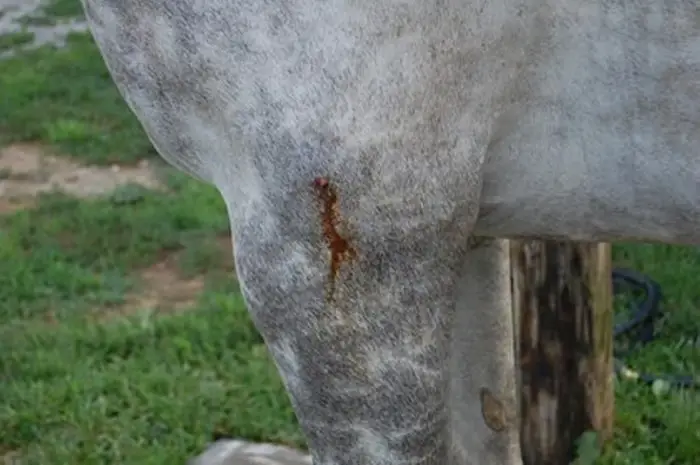
A. Making a Pressure Pad
A severed artery will spurt bright red blood, which can look alarming. Equally concerning is the persistent dark red ooze produced by a cut vein. Try to stop the bleeding by firm applying pressure to the wound in such cases. Make a pressure pad with a thick cloth pad, or use gamgee from your first aid kit with a non-stick dressing underneath. Press the pad on the wound, and hold it there as firmly as possible. It is often simplest to tape it in place to keep it secure. In an emergency, use anything to hand, such as a T-shirt, a big handkerchief, or a towel.
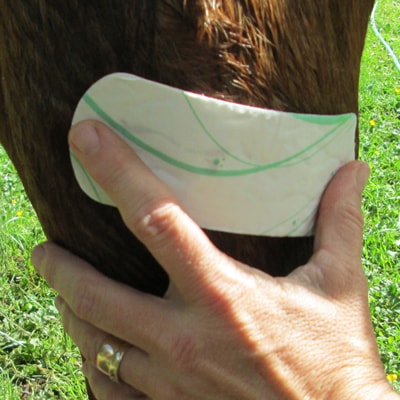
B. Applying a Pressure Pad
Most such wounds are on the lower legs, and direct pressure over the area will control bleeding. If the blood receives through, put more padding over the top of the wound and apply more pressure. You must remain a pressure pad in place for at least five minutes: do not be tempted to remove it and peep underneath, as that can restart the bleeding. This is much better than trying to use a tourniquet.
C. Be Reassuring
Talk to the horse or pony reassuringly as you keep pressure on the wound, encouraging them to stand still. If a horse is excited, the heart pumps faster, increasing the rate of bleeding. But keep them calm and still, and blood will clot more readily.
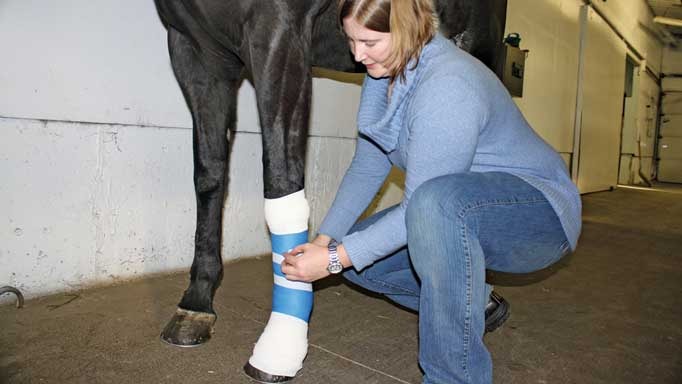
D. Maintaining a Pressure Bandage.
Once you have put on a firm, comfortable pressure bandage and controlled the bleeding, it is safe to leave it in place for up to two hours. Where a horse has incurred more than one injury, identify the primary wound and get that under control; then check the horse elsewhere for the other previously overlooked injuries.
2. Second Step of Equine Wound Management: Clean
Cleaning any wound is essential, but do not probe deeply, encouraging infection or restarting bleeding. The initial cleaning will influence eventual healing, so removing all dirt and debris is vital.
- Gentle hosing will help by washing with a correctly diluted antiseptic solution such as chlorhexidine.
- In an emergency, use water. If you are worried about cleanliness, use approximately 500ml boiled water in a clean container, add a teaspoon of salt.
- Small bags of sterile saline can be kept in the first aid kit to wash out wounds.
- Moist wipes, as manufactured for babies, can be helpful.
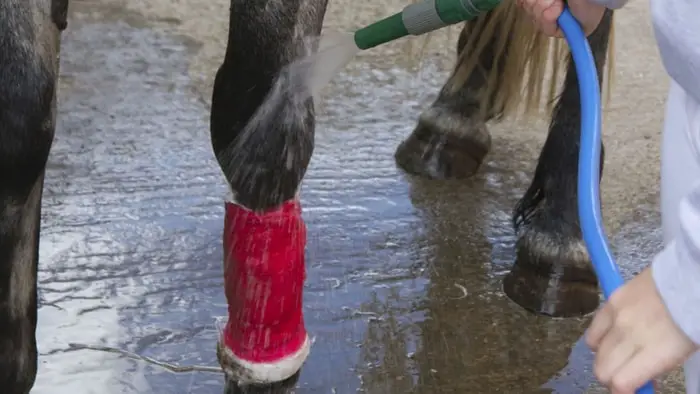
How to Proceed Cleaning Fresh Wound?
How you decide to continue will depend on the severity of the injury.
- If a wound looks awful, you should contact a vet immediately.
- If the damage seems minor, it will help clean up the area and find out what is going on so that you can give the vet more accurate information.
- Make sure your own hands are clean if you are touching the wound.
- Once you have cleaned and washed away the blood, you will often find that the injury is more minor than initially suspected.
- Filling a wound with a suitable wound hydrogel will help provide the right moist, clean environment to encourage healing.
- Then, if possible, trim away the hair from the edge of the wound. This allows the extent of the damage to be seen and prevents hair from contaminating the wound.
- At this stage, the two key things to assess are the wound’s anatomical position and the horse’s overall condition.
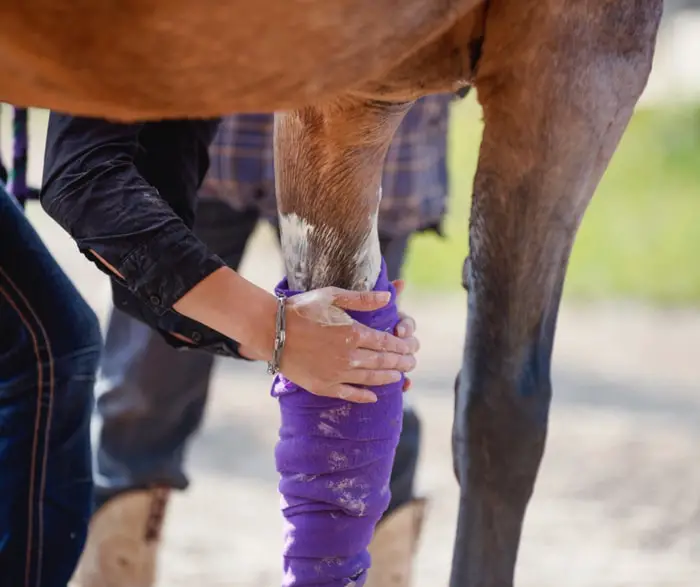
Horse Wound Management: The Position of the Wound
Be vigilant if the wound is located near a vital structure such as a joint or the digital tendon sheath at the posterior of the pastern. Even seemingly superficial wounds can penetrate vital structures and can cripple a horse if they are not treated aggressively right from the start.
- The bones of the equine limb are relatively poorly protected by muscle, so they are at risk.
- If you can see white tissue exposed within the wound, it may be a tendon, ligament, or bone, and you should contact a vet.
- Is the face involved- most eyelid wounds should be surgically repaired, and other head wounds will often heal better if sutured. Obviously, with any significant head trauma, a vet should be contacted to check for underlying damage to the nervous system.
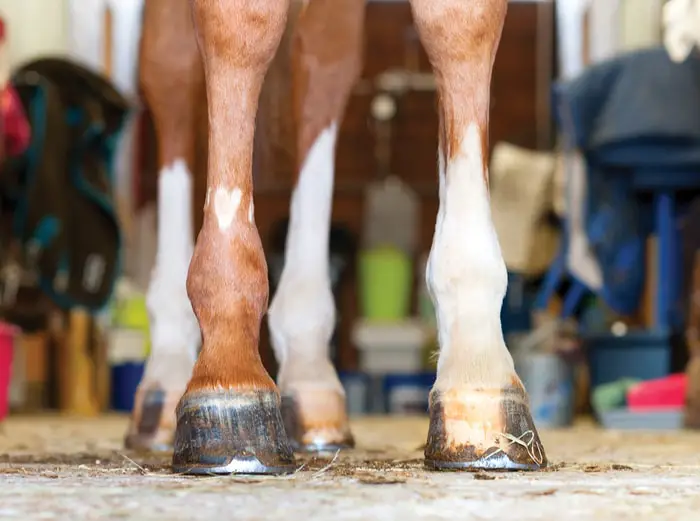
The Overall Condition of the Equine Wound
If the horse is lame then you would expect for the size of the injury, or if he is more distressed than anticipated for the size of the wound, then something serious may be involved. This could be damage to a bone or joint, in which case, again, it requires urgent veterinary attention.
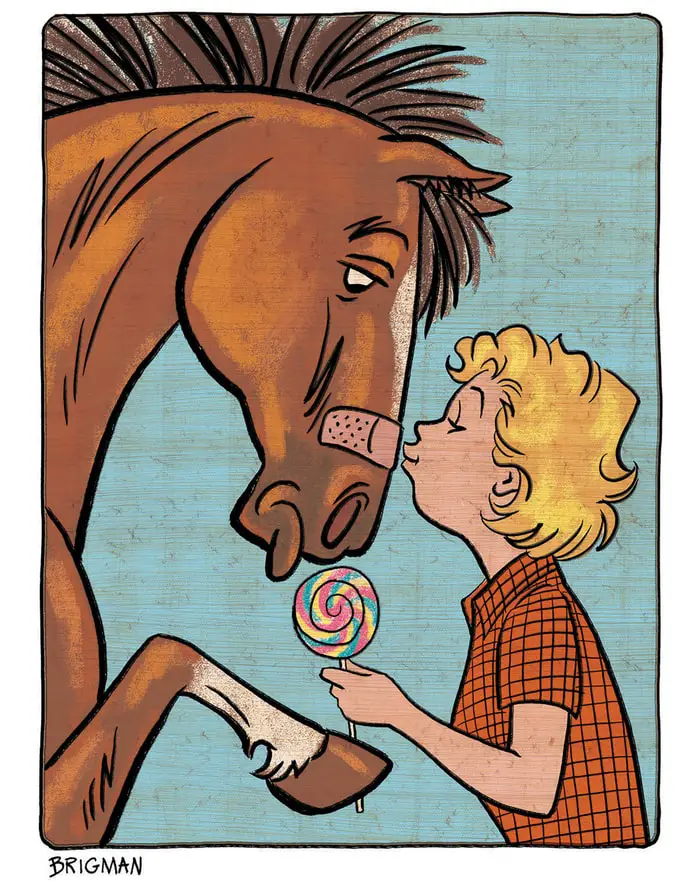
3. Third Step of Horse Wound Management: Cover
There is a tendency to overreact and apply ointments or powders to the wound, interfering with healing. If it is not safe in an eye, it should not go in a wound. Most wounds occur on the lower limb, so they are best bandaged, first to protect them from muck, mud, and bedding, and also to provide a warm, moist environment that encourages rapid wound healing. Use a sterile non-adherent wound dressing to hold some wound gel in place, then bandage routinely. Wounds on the upper body frequently cannot be bandages but should be kept as clean as possible.
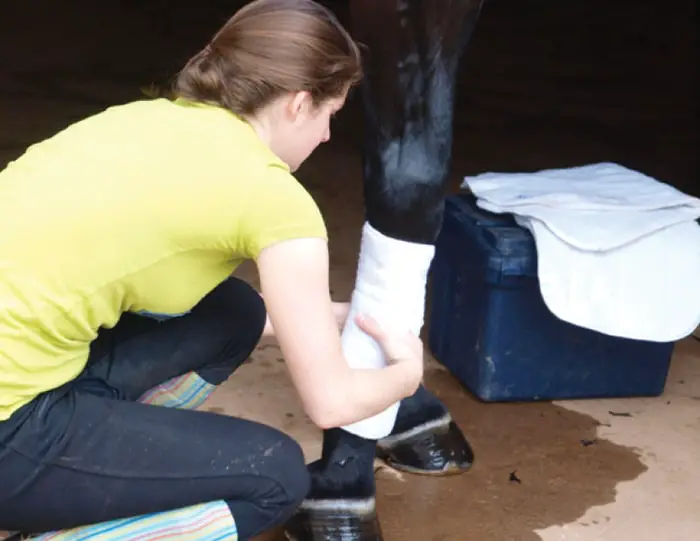
Types of Horse Wounds
Horse wounds that cause concern include lacerations, puncture wounds, and those involving the entry of a foreign body.
1. Laceration Wound
This is a traumatic tearing of the skin uncontrolled and is a common equine injury. The blood vessels tend to be stretched, so bleeding is rarely a problem, although the tissues are bruised and sore. Adequate treatment is impossible until all affected structures are identified.
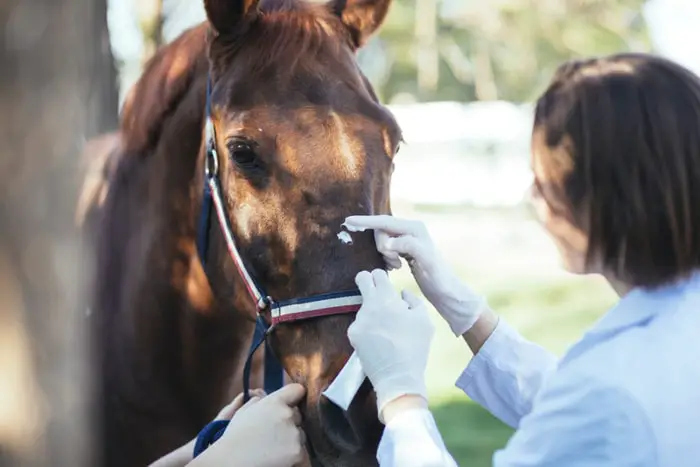
This means that the vet often spends a long time cleaning and preparing the wound before deciding whether it can be repaired immediately or should be referred to a surgical facility. Lacerations requiring special treatment include those involving:
- Tendons and tendon sheaths.
- Extensive skin wounds.
- Bone damage.
- Major blood vessels.
- Coronary band and hoof wall.
- Joints.
Lacerations involving less critical; structures are cleaned, and damaged tissue removed; they may then be stitched at a later stage.
2. Puncture Wounds
Many puncture wounds are so tiny that they are hard to see; sometimes, it can be challenging to identify the injury in the first place! Frequently the first indication of a puncture wound is when swelling appears at the site. Infection can spread extensively from the original wound. This is particularly true on a leg, where the whole limb can swell up following a superficial puncture wound. There is a trickle of blood on the coat or a sensitive scab when feeling the area associated with localized swelling. Sometimes the vet will clip hair away from the area of suspicion to see precisely what is going on.
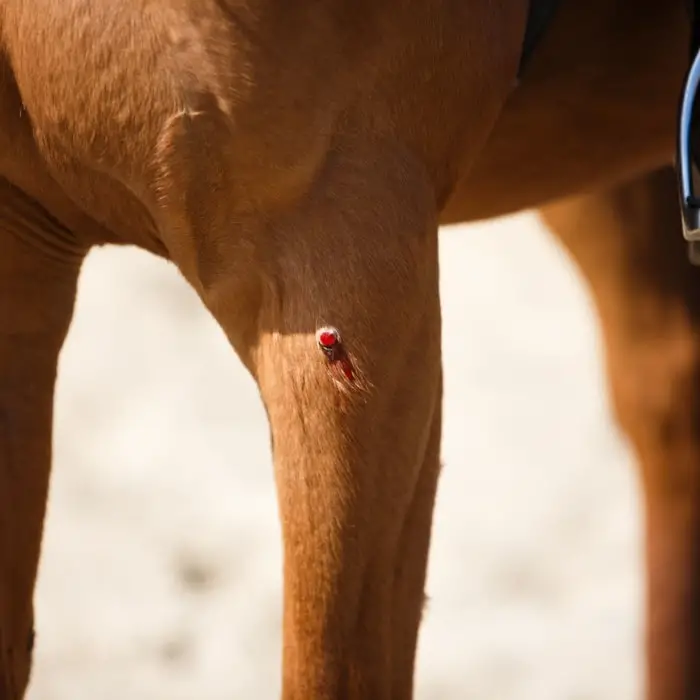
Critical Points for Puncture Wounds Management
First, find the injury! Be aware that minor wounds can have the most severe consequences. The damage caused depends on how deep the wound is, how dirty it is, and whether it has involved any vital structures. Many more trivial superficial wounds will discharge clear or yellow serum, which can appear similar to joint fluid, but if in double, get it checked.
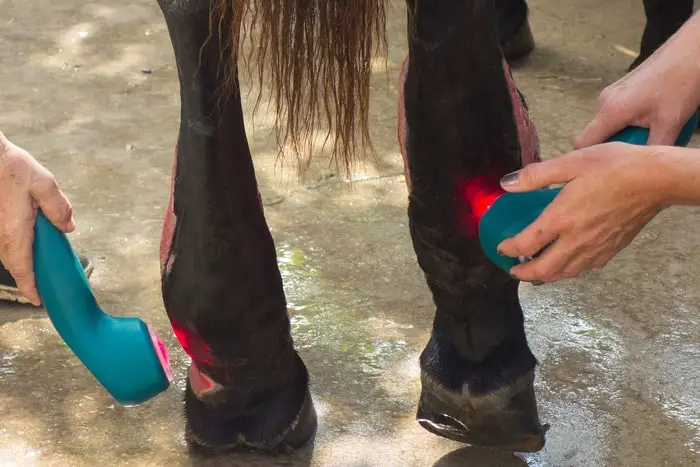
Emergency Treatment for Punctured Wound
Traditionally poultices have been applied to puncture wounds to draw out dirt and debris; however, a wet poultice can encourage infection and be counterproductive. Clip away the coat and clean around any puncture wound. Avoid spraying water, using hydrogen peroxide, or anything else that could go directly into the wound, as this may force dirt deeper. Again, hydrogels are helpful to apply, and a clean bandage helps protect the wound.
I prefer to apply a clean bandage and use a hydrogel on the wound. Ice packs and cold hosing are also beneficial. This type of wound provides the ideal anaerobic environment for tetanus bacteria to flourish. As puncture wounds are often undetected, all horses and ponies should be routinely vaccinated against tetanus; if not adequately protected, vaccination must be obtained. A properly vaccinated horse does not need a booster for every fresh wound.
Consider What Caused the Puncture?
There is always the risk that a foreign body is still stuck inside. Be careful about introducing further infection by probing into any wound. If in double, ask the vet, mainly if a wound does not heal, which would suggest something is rotting inside it.
Is it a Puncture?
Two puncture points close together could be a snake bite, and a hole with pus draining out may be an internal abscess that has burst. Do not underestimate a puncture wound; its small size often disguises an underlying injury of much greater potential severity. Such a wound can be fatal if it affects a vital organ such as the brain, abdomen, chest, or the inside of the foot.
Wounds Due To Foreign Bodies
There is a first aid dilemma. If there is a foreign body wedged in a wound, in most circumstances, it is best left there until you have veterinary help, unless it is very loose. Most foreign bodies, when found, are truly wedged in place; otherwise, they would have fallen out already! Many can be extremely difficult and potentially painful to remove, and a vet should do this with the help of appropriate painkillers and sedatives and then check the injury properly.
A foreign body may break off within a wound, so the site of the accident and any potential foreign bodies- for example, a splinter from broken fencing- should be noted. Wood is a high-risk material, as it may splinter deep within a wound and only be detected months later when the injury fails to heal.
Foreign Bodies in the Foot
Where the foot is concerned, the opposite applies, in that if the horse has stood on a nail, it is usually best to remove it. Before his weight pushes, it is any further. The critical issue is which part of the foot is affected.
4. Equine Wounds: Stake Wounds
This type of wound has the potential to penetrate a body cavity, with the risk of a foreign body being stuck inside. Always think about what is inside the horse’s body, rather than worrying about just the skin injury itself. Horses sometimes stake themselves on fence posts around the chest or abdomen that is not penetrated; many such wounds heal very well. Even so, you should still contact a vet urgently.
Horse Wound Management: When to Contact a Vet
Call your vet in the following circumstances:
- When any wound is bleeding profusely.
- When a horse is very lame, even if the wound is small.
- When a wound is more than 6cm long and has gone right through the skin.
- If you consider, there may be a foreign body in the wound.
- If you suspect a vital structure such as a joint is involved.
- If a horse has not had an anti-tetanus vaccination.
Horse Wound Management: Are Stitches Necessary?
Many horse wounds will heal very well without stitches, and these are often not as necessary as people think. This is particularly true on equine limbs, where the blood supply is frequently poor. If it is to be stitched, a wound should meet the following criteria: it should,
Horse Wound Management: Few Final Guidelines
1. Be Accessible
If, for example, it is inside the back leg and the horse kicks, it will not be possible to do a decent job without heavy sedation or even general anesthesia.
2. Be Clean and Fresh
If you do not find the injury until the day after and the skin edges are dried up, suturing will unlikely improve it.
3. Have the Blood Supply Intact
A vet will be the one to decide this, but many jagged lacerations, especially upward-pointing flaps on the limb, do not mend well.
4. Have Enough Skin to Hold Together without Tension
There is excessive motion- for instance, at the front of the knee, where the wound will move every time the leg bends- the chances of stitches staying in place are poor. Sometimes vets will apply a very heavy bandage or cast the leg to minimize bending.
5. Be without Infection
An infected wound is not going to heal efficiently. Wounds with severe bruising from impact injuries are more likely to become seriously infected than are, say, lacerations caused by sharp objects; because of this tendency, they are often best not stitched.
The best wound to stitch is the fresh, clean-cut that has just happened. Most horse wounds are dirty and not ideal for suturing; however, the vet looking at the horse must decide. Never pressure a vet into suturing a wound in an emergency: it is far better to ensure it is clean and healthy by leaving it open to drain. It may be possible to repair some wounds days after the initial injury when swelling and contamination have been reduced.
Such delayed repair is often underused, as everyone wants an immediate solution. Remember that wounds shrink, which will help heal, especially in ponies. Wounds below the hock and the knee in big horses can be slow to heal and need good nursing. They will often need bandaging as protection to help heal.
6. Promoting Healing
A comfortable animal will heal better. With any wound, tetanus protection and appropriate antibiotics are required. Painkillers will also help the horse.
Concluding Remarks on Horse Wound
The wound is a common ailment in horses. The wound may be due to laceration, an accident during training, exercise, walking, or grazing. You will often face this situation, and it needs careful handling. In my article, I have briefly discussed all points on equine wound management. I think this information will help you a lot for better horse management.